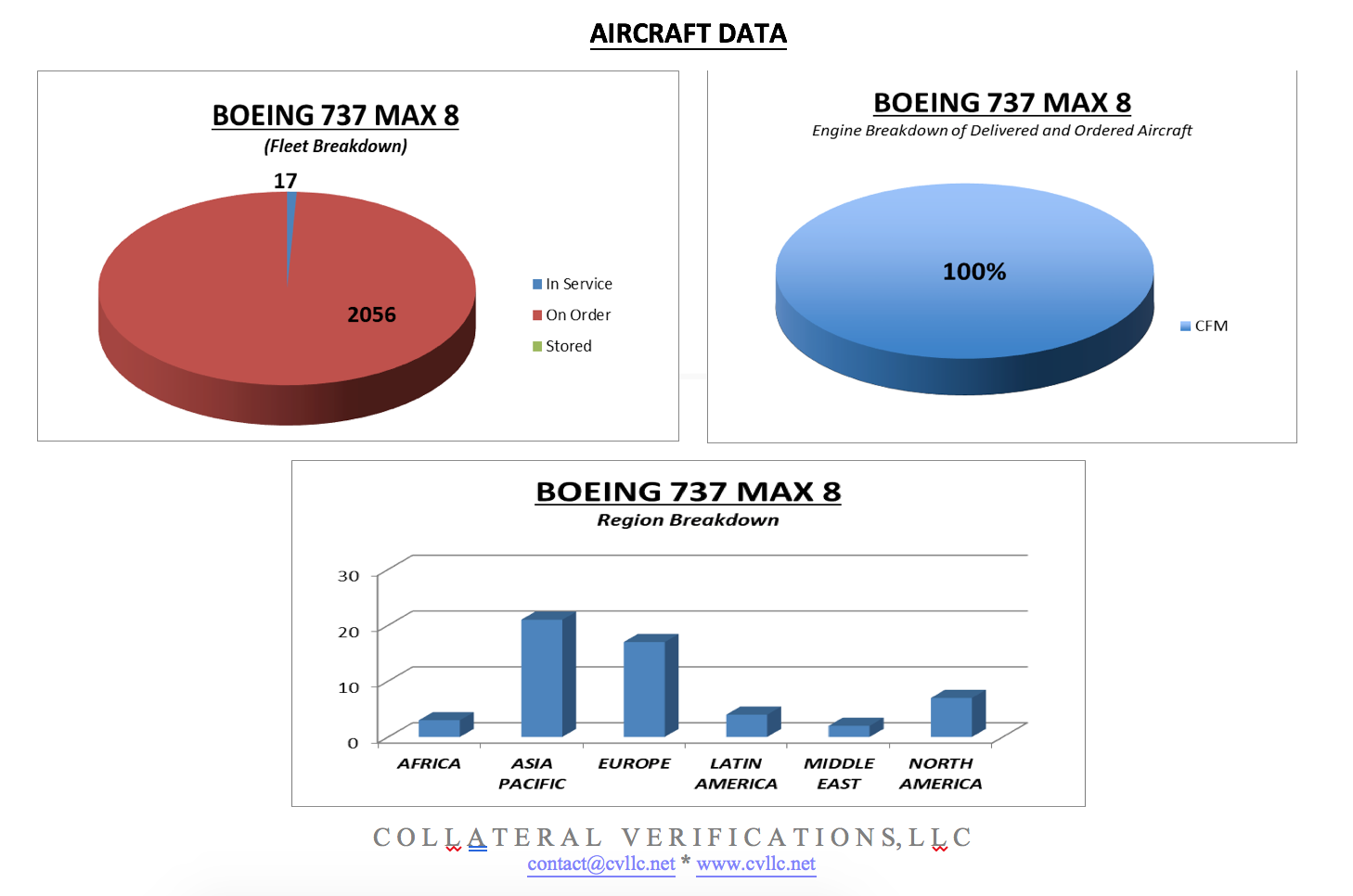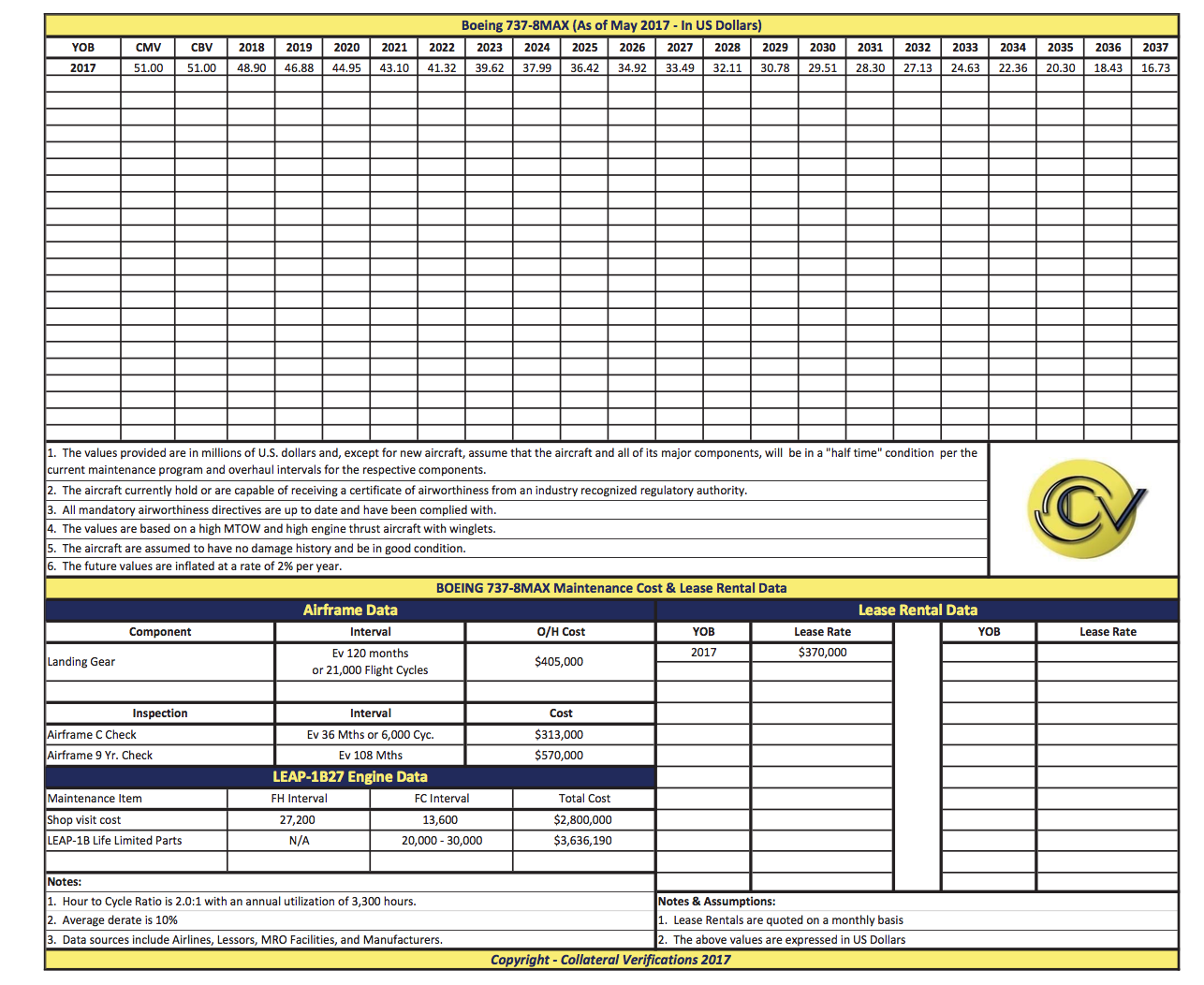
AIRCRAFT MARKET SUMMARY
The Current Market
The current market demand for the Boeing 737 MAX has continued to remain strong since the launch of the aircraft in 2011. This demand has kept values and lease rates steady in the last 12 months with normal increases year over year due to pricing escalation. Today, CV knows of no aircraft listed as available for sale and/or lease. Out of 17 aircraft delivered, none are currently in storage, which is expected for such a young aircraft type. It is CV’s opinion that these percentages are considered average for the fourth generation of a single-aisle aircraft type that has been in production for over 50 years.
As mentioned above, current values in today’s market have remained stable and even increased slightly due to normal pricing escalation and the strong demand for the type. The potential increase in the production rate, in 2019, by Boeing may have a negative impact on values and lease rates over the long term but the short-term results will be unaffected due to the continued demand for the aircraft. This trend, which continues to show signs of stability due to the improving state of the industry in certain regions, is expected to continue over the next 12 months. Although some indications that the global economy may be slowing in certain countries, we do not see the much potential for values and lease rates of this aircraft to for the foreseeable future.
In looking at the leasing market, this aircraft is now leasing for around $370,000 per month for new aircraft on average which is around a $30,000 premium over the Boeing 737-800. With the planned increases in production from Boeing and low fuel prices making used aircraft very attractive, it has created quite a bit of competition for the lessors to place new aircraft which has put pressure on lease rates. As fuel prices rise and airlines shift their focus to new generation aircraft, such as the Boeing 737 MAX or A320NEO, we expect lease rates to strengthen and increase over time.
CV believes that the Boeing 737 MAX 8 will become the next most popular single-aisle aircraft with operators and financial institutions alike. Not unlike its older sibling, the 737G, demand for this aircraft will remain strong well through the next decade.
VALUE DEFINITIONS
Current Market Value (CMV):
The Current Market Value (CMV) of an aircraft is the appraiser’s opinion of the most likely trading price that may be generated for an aircraft under the market circumstances that are perceived to exist at the time in question, according to the International Society of Transport Aircraft Trading (ISTAT). The current market value assumes that the aircraft is valued for its highest and best use, that the parties to the hypothetical sales transaction are willing, able, prudent and knowledgeable, and under no unusual pressure for a prompt sale, and that the transaction would be negotiated in an open and unrestricted market on an arm’s length basis, for cash equivalent consideration, and given an adequate amount of time for effective market exposure to perspective buyers.
Base Value (BV):
Base value is the appraiser’s opinion of the underlying economic value of an aircraft in an open, unrestricted, stable market environment with a reasonable balance of supply and demand, and assumes full consideration of its “highest and best use”. An aircraft’s base value is founded in the historical trend of values and in the projection of future value trends and presumes an arm’s length, cash transaction between willing, able and knowledge parties acting prudently, with an absence of duress and with a reasonable period of time available for marketing.
METHODOLOGY
Current Market Value (CMV):
To determine current market values of aircraft, CV uses, as our main source of data, any and all known reported market values. These values are extracted from numerous aviation industry sources and from CV’s proprietary and confidential transaction database.
As a secondary consideration, CV also analyses and gathers data on factors that influence the market value of an aircraft, such as its age, condition, configuration, fleet composition of such aircraft, similar aircraft available to the market, number of aircraft stored, operating economics, new aircraft prices, and the current state of the environment for the aviation industry.
This information is then entered into CV’s own proprietary transaction database and analyzed to determine a current market value based on a single sale transaction and using the assumptions as outlined in each aircraft valuation report at the time specified on the report.
Base Value (BV):
To determine its Base and Future values, CV first analyses any and all transaction information within its own proprietary database. This analysis allows CV to then establish the new price of an aircraft at a specific point in time. Historical data is then analyzed to determine the average depreciation rates of aircraft based on various conditions. This analysis is also broken down by aircraft type, mission, and in or out of production status. The result of these analyses is a depreciation factor which can then be applied to the various aircraft valuation models which CV utilizes for its valuation services and publications. Based on each valuation model, CV then creates base value curves for each aircraft which provide the base and future values for the aircraft which are reflected in the Turbine Aircraft Guide.
Lease Rentals:
The Lease Rentals provided in each valuation report represent CV’s opinion of aircraft lease rates in today’s operating lease environment. These lease rates are derived from CV’s own proprietary transactions database which contains a wide range of lease transactions received from numerous sources within the industry. This data is then compiled to produce the lease rentals provided in each aircraft valuation report.
Maintenance Cost Data:
The maintenance cost data provided in the Turbine Aircraft Guide is information that has been collected from various industry sources such as maintenance publications, conferences, MRO facilities, manufacturers, and financial institutions. The data represents the current estimated maintenance costs for such aircraft based on the assumptions and conditions provided.
Statement of Independence:
The aircraft valuation reports provided in the Turbine Aircraft Guide represent the opinion of Collateral Verifications and are intended to be advisory in nature. Therefore, CV assumes no responsibility or legal liability for actions taken or not taken by the purchaser of the Turbine Aircraft Guide or any other party with regard to the data provided in each report. By accepting these reports, the purchaser agrees that CV shall bear no responsibility or legal liability regarding these reports. CV also states that these valuation reports have been independently prepared and fairly represents the aircraft and CV’s opinion of its values.

